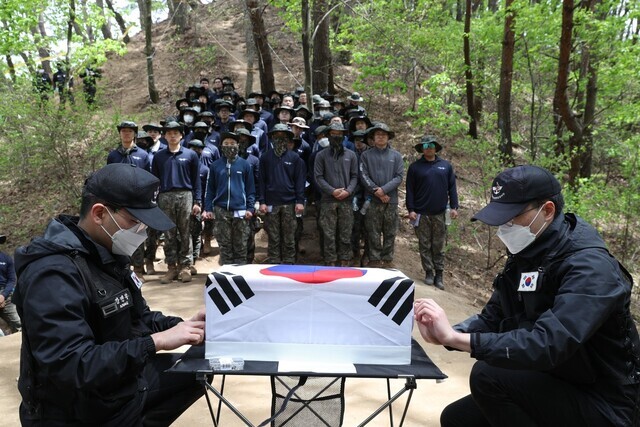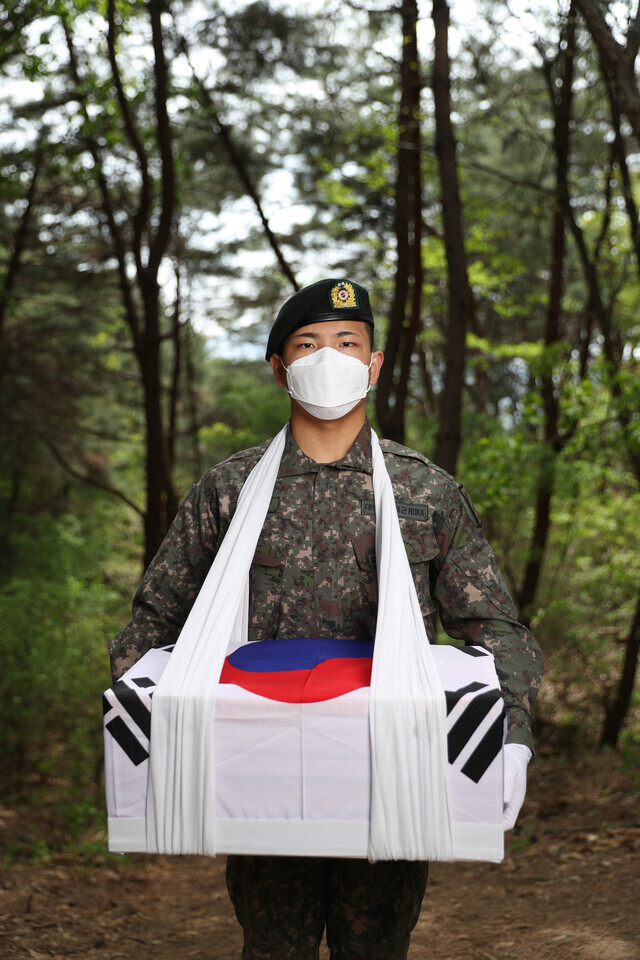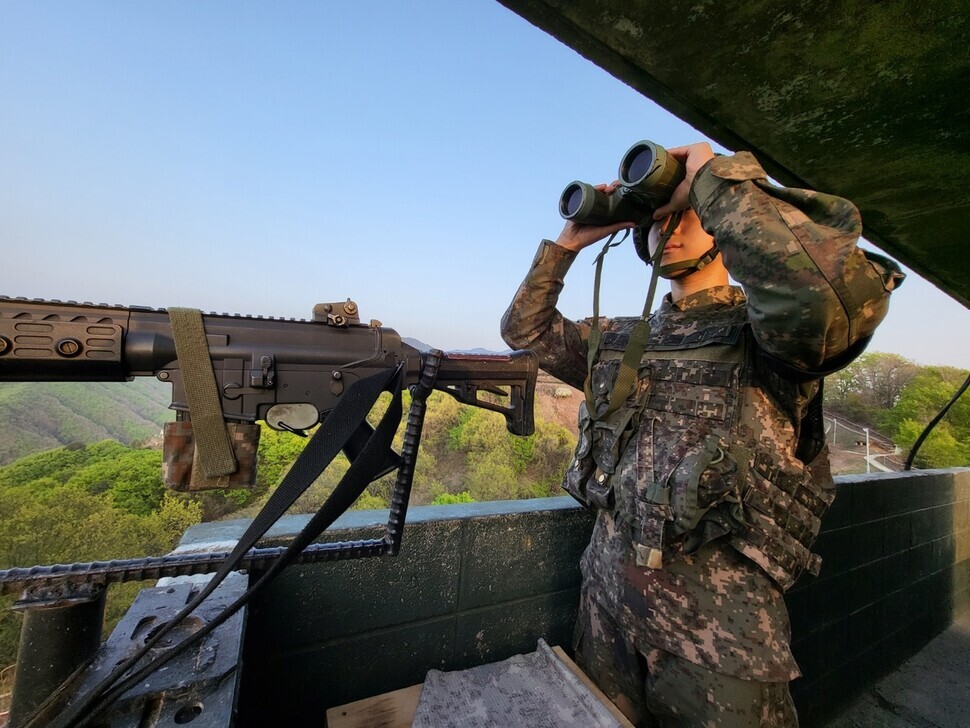hankyoreh
Links to other country sites 다른 나라 사이트 링크
In DMZ-adjacent hills, exhumed remains show brutality of Korean War 70 years on

Editor’s note: This year marks the 70th anniversary of the Armistice Agreement that halted the fire of the Korean War (July 27) and of the South Korea-US Mutual Defense Treaty (Oct. 1). For the armistice anniversary, the Hankyoreh paid visits to Hongcheon, Gangwon Province, where the remains of soldiers killed in the Korean War are being exhumed, and to the Demilitarized Zone by the 7th Infantry Division in Hwacheon, where tensions are swirling.
Even today, the remains of over 100,000 soldiers remain buried in hills throughout Korea. In a sense, the Korean War continues until those remains have been returned to the soldiers’ families.
“The path that you are walking on right now is a battlefield that our predecessors risked their lives traveling up and down 70 years ago.”
This is the text on a banner at the entrance leading to a site where the remains of Korean War troops are being exhumed in Jueumchi, a village in the Hwachon township of Hongcheon County, when the Hankyoreh visited on the afternoon of April 28. The banner was put in place by the South Korean Ministry of National Defense and the ROK Army 11th Maneuver Division.
A roughly 20-minute trip up a dusty, steep mountain path from the banner led to the exhumation site. Soldiers with the Defense Ministry’s remains exhumation and identification corps and the 11th Maneuver Division’s assault battalion were carefully digging with shovels in the earth on the lower mountain slopes.

Seventy-two years ago, this was the site of the Northern Battle of Hongcheon (May 16–18, 1951), which was fought to repel a spring offensive by the Chinese Communist forces. At the time, South Korean and US troops retreated to what is today the Jueumchi exhumation site, around 10 kilometers from Mount Gari to Hongcheon’s northwest.
“We’ve retrieved 12 sets of remains from this site, and there has been one complete set with all of the bones intact,” explained Han Jeong-hui, leader of the exhumation and identification corps’ exhumation team.
“The reason so few of the remains are intact is because of the strong likelihood the victims were torn apart by shells at the time of their death due to the fierce artillery warfare,” Han explained.
Many exhumations of soldiers killed in the Korean War take place on hills, ridges, and other higher locations. Seventy-two years ago, those hills were hellscapes where bodies lay in piles as other soldiers used them for shields. Today, they are mellow lower mountain slopes, lush with greenery and lit with spring sunshine.
Kim Do-hun, a corporal with the 11th Maneuver Division’s assault battalion who was taking part in the dig, said, “When you’re exhuming remains, there are moments when you imagine the fighting at the time and it leaves you feeling somber.”
The Seoul National Cemetery honors around 103,000 victims with plaques in the absence of remains — the majority of them being soldiers killed in combat. The exhumation of those soldiers’ remains can only take place when the government shares the value of recognizing the preciousness of each Korean’s life and dignity.
This kind of perspective is only possible when people are viewed as the owners of the country rather than subjects to be ruled over. It was April 2000 when, after a horizontal change of power in domestic politics, the state first took systematic action to unearth the remains of fallen soldiers.
The Korean War was fought between people of the same nation wearing different military uniforms. “It is not easy to tell the difference simply by looking at the remains,” said excavation team leader Han Jeong-hi. “Similar to the film ‘The Front Line,’ in which a South Korean soldier wears a North Korean uniform on top of his own because of the cold, you sometimes find items from enemy forces with remains that are believed to be from the South Korean army, and vice versa.”
“We do distinguish between North and South Koreans at the site, but [each discovery] is carefully screened through several sessions of the Friend or Foe Determination Committee,” said Han.

The affiliation of each soldier is determined by looking at their uniform, helmet, buttons and weapons in addition to the remains. If weapons such as M1 or carbine bullets or American-made grenades are found alongside the body, the individual is judged to be a South Korean soldier. Conversely, soldiers are classified as North Korean based on combat boots imprinted with the “Pyongyang” mark, weapons from the former Soviet Union such as TT pistols, or a helmet with a star symbol. The armies of both Koreas also had differently shaped buttons at the time, making buttons an important clue in deciphering each soldier’s affiliation.
After this process, the remains of soldiers classified as North Korean are buried in the Cemetery for North Korean and Chinese Soldiers in Paju, Gyeonggi Province. The South Korean government built the cemetery, originally named the “enemy soldier cemetery,” in 1996 in the interest of respecting the Geneva Convention. Article 34 of the Protocols Additional of the Geneva Convention states the remains of enemy soldiers who have died as a result of hostilities shall be respected, and grave sites shall be maintained for such persons.
Those who stick to the idea that South Korea should not honor “commies” claim that having a gravesite for the enemy is akin to building a shrine for pro-North Korea sympathizers. They take issue with the fact that the Moon Jae-in administration attempted to build a peace park on the site of the Cemetery for North Korean and Chinese Soldiers, where 58 spies are buried, based on the argument that even bones have ideological affiliations.
This reminds me of the phrase “bones don’t have colors” uttered by the late Kim Cheol-ho while walking down a mountain path under the warm spring sun one day after finishing an interview. When businessman and social entrepreneur Kim Chul-ho (1922-1995) visited the area around Mount Jiri in 1990, he was saddened to think that no one had recovered the remains of those who lost their lives on the mountain during the Korean War.
“Ashes cannot be left-wing or right-wing, and bones don’t have colors,” he said.
Kim built a mud hut on Mount Jiri and put together a park to honor the casualties of the division between the two Koreas. Having stood on the site where the remains of fallen soldiers are being excavated, I can confirm that the bones did not have colors.
On the afternoon of April 27, I was able to reflect on the war that has still not ended at the Chilseong observation deck in Hwacheon County within the DMZ. That day, the panoramic view of northern mountains and fields was quiet and peaceful. I was also able to see the leisurely swirling waters of Geumseong Stream, which flows from the south to the north and then back toward the south due to the nature of Korea’s geography, with mountains to the south and low-lying regions to the north. Hills 425 and 406, located near to the stream, looked close enough to touch.
Hwacheon is known for its landscape due to the beauty of its high mountain peaks and mountainous terrain. Even the area around the Chilseong observation deck is lined with mountains more than 1,000 meters above sea level, including Mount Jeokgeun (1,073m) and Mount Baegam (1,178m).
After immersing myself in the mountain scenery for some time, an eerie feeling came over me as I thought about how these mountains derived their names from the soldiers who had once defended the DMZ. Mount Jeokgeun’s name is an abbreviation for the Korean phrase “a place soaked to the roots of the trees in the enemy’s blood,” while Mount Baegam means “the mountain that turned white due to bombing during the war.”

The high-altitude battles fought on the central and eastern fronts during the Korean War were fierce enough to lead to these interpretations. “The places you can see from the Chilseong observation deck are where the hill battles were fought,” a military official told me.
Most people remember the Great Naktong Offensive, Battle of Incheon, and the Battle of Chosin Reservoir that took place between summer and autumn of 1950 during the Korean War, believing that these clashes were responsible for the highest number of casualties. However, the greatest losses on both sides actually occurred during the war for the hills that lasted from the summer of 1951 to the summer of 1953.
Geumseong Stream ran red with blood in the lead-up to the signing of the Armistice Agreement 70 years ago in July 1953. The 7th Infantry Division of the South Korean Army fought a bloody battle with Chinese Communist forces on Hill 425 and Hill 406 from July 20 to July 24, 1953. This is referred to as the final battle of the Korean War.
At the time, the Chinese lost 1,605 soldiers, while the South Korean army suffered 114 deaths, 438 injuries and 83 missing. With the victory on Hill 425 and Hill 406, the 7th Infantry Division shifted the 38th parallel 35 kilometers north, which is where it remained when the Armistice Agreement was signed three days later.
Major Lee Gyu-hak (posthumous honor, captain at the time) was killed in battle on Hill 406 on July 24, just three days before the signing of the agreement. Several days before his death, he wrote a letter to his wife stating, “I do not know what mission I will be given when daylight comes, but tonight I thought of my hometown and dreamed of you.”
Lee’s family simply received a notice of his death and have been unable to identify his remains for 70 years because they are located on Hill 406, which is inaccessible due to being within the DMZ. If a search for remains under the inter-Korean military agreement signed on Sept. 19, 2018, had achieved success on Arrowhead Hill in Cheolwon, it would have been possible to conduct a joint excavation of remains on Hill 406 in Hwacheon as well. However, even the original plan eventually foundered as inter-Korean relations turned sour. For Lee and his family, the Korean War is a war that continues to this day.
The frontlines of battle went back and forth along the area now known as the Military Demarcation Line during two years of ceasefire negotiations from July 10, 1951, until July 27, 1953. An investigation by the Ministry of National Defense’s Institute for Military History found the high-altitude battles that took place during this period were used as a tool to break the deadlock in negotiations. Its report also claims that both sides engaged in offensive and defensive battles over certain areas more for the purpose of dealing blows to the enemy than achieving a military victory. The institute believes the battlefield was dominated by gruesome attempts to secure the high ground in which countless lives were sacrificed to occupy a single hill.
Sniper Ridge, which lies to the west of Chilseong observatory deck, is a protruding ridge that stretches out from Mount Oseong toward the Gimhwa region of Gangwon Province. At least 20,000 soldiers were killed or injured attempting to occupy this ridge between Oct. 14 and Nov. 24, 1952. Chinese records list 25,000 casualties for South Korean and UN forces, with 11,000 for the Chinese army, while the figures in South Korean records are 11,000 for the Chinese and 7,800 for the South Korean and UN forces. The loss of 20,000 or so soldiers in the course of a month due to maintaining close formation in the narrow 1-square-kilometer area of Sniper Ridge is unprecedented in the history of war throughout the world.
Why couldn’t we stop the horrific high-altitude fighting in the Korean War?
“It’s because we knew we couldn’t win, but we also didn’t want to lose. No one won the battle, and what happened was that many soldiers did not return home,” commented Kim Yeon-chul, who formerly served as South Korea’s minister of unification.
In the DMZ, time appears to have stayed frozen for 70 years. Although the mountain streams have remained unchanged, already three generations of soldiers have entered the zone and left.
In particular, the 7th Infantry Division was the first on the eastern front to introduce a scientific perimeter system in July 2015. Troops no longer have to work on surveillance themselves, but various surveillance and detection equipment such as high-performance cameras are utilized. In the DMZ, the past (war), present (division), and future (reunification) coexisted in tension.
Viet Thanh Nguyen, a Vietnamese American novelist, once said, “all wars are fought twice, the first time on the battlefield, the second time in memory.” The state is trying to monopolize memories related to war.
In March, on the 70th anniversary of both the Armistice Agreement and the South Korea-US alliance, the Ministry of Patriots and Veterans Affairs set out a business plan under the theme “Amazing 70,” which will include thanking veterans for their “great commitment” and sharing the “value of freedom” with the international community. While we can express our gratitude for the 70 years that have passed, we must also envision a starting point for peace by putting an end to this war that continues seven decades years on.
By Kwon Hyuk-chul, staff reporter; Photography by Kim Bong-gyu, senior staff writer
Please direct questions or comments to [english@hani.co.kr]

Editorial・opinion
![[Editorial] Intensifying US-China rivalry means Seoul must address uncertainty with Beijing sooner than later [Editorial] Intensifying US-China rivalry means Seoul must address uncertainty with Beijing sooner than later](https://flexible.img.hani.co.kr/flexible/normal/500/300/imgdb/original/2024/0517/8117159322045222.jpg) [Editorial] Intensifying US-China rivalry means Seoul must address uncertainty with Beijing sooner than later
[Editorial] Intensifying US-China rivalry means Seoul must address uncertainty with Beijing sooner than later![[Column] When ‘fairness’ means hate and violence [Column] When ‘fairness’ means hate and violence](https://flexible.img.hani.co.kr/flexible/normal/500/300/imgdb/original/2024/0516/7417158465908824.jpg) [Column] When ‘fairness’ means hate and violence
[Column] When ‘fairness’ means hate and violence- [Editorial] Yoon must stop abusing authority to shield himself from investigation
- [Column] US troop withdrawal from Korea could be the Acheson Line all over
- [Column] How to win back readers who’ve turned to YouTube for news
- [Column] Welcome to the president’s pity party
- [Editorial] Korea must respond firmly to Japan’s attempt to usurp Line
- [Editorial] Transfers of prosecutors investigating Korea’s first lady send chilling message
- [Column] Will Seoul’s ties with Moscow really recover on their own?
- [Column] Samsung’s ‘lost decade’ and Lee Jae-yong’s mismatched chopsticks
Most viewed articles
- 1For new generation of Chinese artists, discontent is disobedience
- 2[Editorial] Transfers of prosecutors investigating Korea’s first lady send chilling message
- 3[Exclusive] Unearthed memo suggests Gwangju Uprising missing may have been cremated
- 4[Editorial] Intensifying US-China rivalry means Seoul must address uncertainty with Beijing sooner t
- 5S. Korea “monitoring developments” after report of secret Chinese police station in Seoul
- 6N. Korean media upgrades epithet for leader’s daughter from “beloved” to “respected”
- 7Yoon says concern about biased diplomacy is being incited by “communist totalitarian forces”
- 8[Column] US troop withdrawal from Korea could be the Acheson Line all over
- 9Xi, Putin ‘oppose acts of military intimidation’ against N. Korea by US in joint statement
- 1060% of young Koreans see no need to have kids after marriage